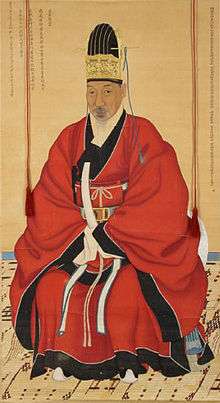Gwanbok
| Gwanbok | |
 Heuk dallyeongpo in the late 18th century | |
| Korean name | |
|---|---|
| Hangul | 관복 |
| Hanja | 官服 |
| Revised Romanization | gwanbok |
| McCune–Reischauer | kwanbok |
Guanfu is a East Asian cultural sphere's general term referring to all business attires of government officers given by government, with Rank badge on them to distinguish hierarchies.
In Korea, It began to be worn since Silla period until Joseon Dynasty. In the early Silla period, the official clothing system of Tang dynasty was introduced into Korea.[1] Until Joseon Dynasty, the Gwanbok system was largely influenced by the clothing system of other cultures, especially by Chinese and nomadic cultures in Western Asia. However, Korea had a dual clothing tradition, in which rulers and aristocrats adopted different kinds of mixed foreign-influenced style, while the commoners had a distinct style of indigenous clothing that today is known as Hanbok.
There were several types of gwanbok according to status, rank, and occasion such as jobok, jebok, sangbok, gongbok, yungbok, and gunbok. Jobok was the gwanbok worn for special occasions such as national festivals, or announcement of royal decrees. Jebok was the gwanbok worn while an ancestor veneration ritual called jesa was held. Sangbok was worn as a daily official clothing while gongbok was worn when officers had an audience with the king at the palace. Yungbok was related to military affairs.
However, as the term in a narrow scope only denote the gongbok and sangbok, it means dallyeong, robe with a round collar.[2][3]
Gallery
 Gwanbok in the Goryeo period, 11th century.
Gwanbok in the Goryeo period, 11th century. Gwanbok in the Goryeo period, 14th century.
Gwanbok in the Goryeo period, 14th century. Gwanbok in the 15th century
Gwanbok in the 15th century Gwanbok in the 17th century
Gwanbok in the 17th century Geumgwan Jobok in the late 18th century
Geumgwan Jobok in the late 18th century Sibok in the late 18th century
Sibok in the late 18th century Gwanbok in the 19th century
Gwanbok in the 19th century
References
- ↑ 김부식 (1145). 삼국사기 (三國史記) (in Korean). Retrieved 2014-11-07.
新羅之初, 衣服之制, 不可考色, 至第二十三葉法興王, 始定六部人服色尊卑之制, 猶是夷俗, 至眞德在位二年, 金春秋入唐, 請襲唐儀, 太宗皇帝詔可之, 兼賜衣帶, 遂還來施行, 以夷易華, 文武王在位四年, 又革婦人之服, 自此已後, 衣冠同於中國
- ↑ "Veteran Korean Designer Enchants Smithsonian Museum". Chosun Ilbo (English Edition). 2007-05-18. Archived from the original on 2007-10-09. Retrieved 2007-11-29.
- ↑ 관복 (官服) (in Korean). empas/Encykorea. Retrieved 2007-11-29.
| Wikimedia Commons has media related to Gwanbok. |